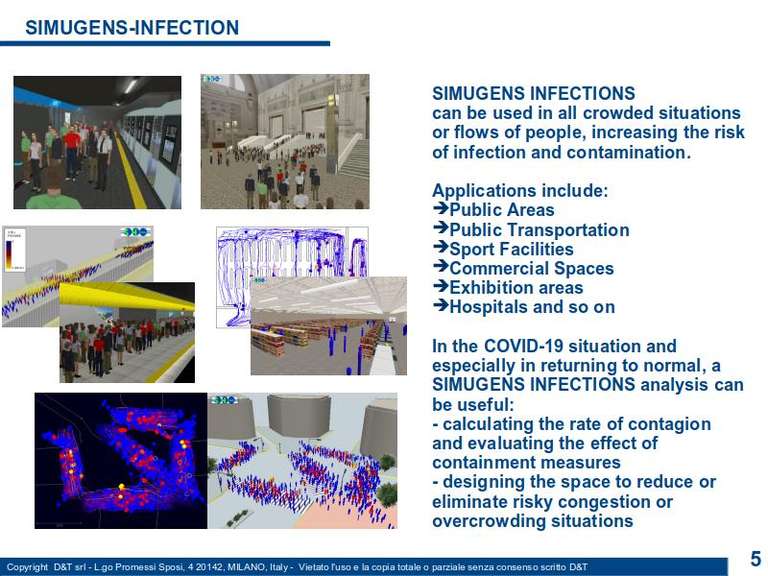SimuGens
Study of crowd dynamics
D&T SHRail division offers engineering services in the study of crowd dynamics, thanks to the experienced team of specialists and its proprietary software SimuGens.
The SimuGens software, developed in 2012 by D&T-SHRail and constantly updated, is an agent-based crowd simulator. It is able to simulate the behavior of single individuals in large groups, even of the order of tens of thousands of people, modeling constraints and other typical elements of crowd conditions (signs, dangers, indications).
It operates in a continuous 3D space, importing the geometries directly from CAD, and allowing visualizations of crowd dynamics both in 2D and 3D. You can also define virtual cameras to simulate control monitors, or set the subjective view, and follow the behavior of a specific individual during the simulation.

The outputs of our study can be in both 2D and 3D. It is possible to visualize the behavior of the crowd in two dimensions (called two-dimensional or plan), in real time, on a map, representing in a synthetic and immediate way parameters of interest such as pressure, speed, distance travelled, and population to which they belong. It is also possible to view the simulation in 3D (Virtual Reality) in real time (compatibly with the calculation power).


The software also allows the export of the simulated quantities in the form of tables of numerical results or graphs of significant quantities of the analysis. You can also export qualitative/visual results as still images or digital video.
SimuGens is a constantly evolving simulator that can in fact be customized according to customer needs and the specificities of individual study projects.
In 2020, following the outbreak of COVID-19, SimuGens was expanded with a series of functions dedicated to the dynamics of infections within crowds to evaluate possible solutions or mitigations to the problem. SimuGens can now simulate infections of individuals based on distance between people, and exposure times, as well as infecting objects or surfaces, calculating the infection rate over time.
The SimuGens functions for infection simulation include:
- infection % for simulated populations
- infection exposure time and distance
- modelling of immune and infected people
- modelling of infected objects and areas
SimuGens simulations can assess infection rates for modeled areas under as function of:
- infection parameters
- people density and flows
Allowing the evaluation of mitigation solutions such as:
- crowd separation/segregation
- flow management and limitations
In SimuGENS, the crowd is represented by individuals (agents) following a partial behavior model; space is continuous, without the limits imposed by grid or cell structures. The following can, therefore, be accurately represented:
- arbitrary environments (buildings, corridors, roads, docks, etc.)
- complex obstacles (walls, handrails, barriers, controlled access, vegetation, etc.)
- large spaces (stations, city districts, areas for outdoor concerts, exhibition areas for fairs, etc.)
The mathematical model of our software consists of the following elements:
CROWD
the crowd is represented by one or more groups of individuals. Each group may have different characteristics, behaviors, intentions, origins and destinations.
INDIVIDUALS
each individual is represented by a cylinder with characteristics of volume, mass, maximum speed, and behavioral handicaps. Each individual interacts with other individuals by means of nonlinear contact forces that act within a characteristic radius, creating resistance to crushing and contributing to pressure on the individual.
WALLS
individuals are constrained by barriers of arbitrary shapes that can represent: rigid or non-rigid walls, masonry, barriers, awnings, rigid or non-rigid transparent walls, gates, windows, vegetation.
POLES
individuals are influenced by elements (poles): attractors, repulsors, or others that encourage movement. Poles can be: visual indications, signs, emergency lights, exits, visible dangers such as flames, threats, signs; generic destinations, directions, destinations, or audio announcements. Poles can arbitrarily affect one or more groups of people and may be: permanent or waypoints. The poles can be activated/deactivated at any time.
Back to: Our Services.













